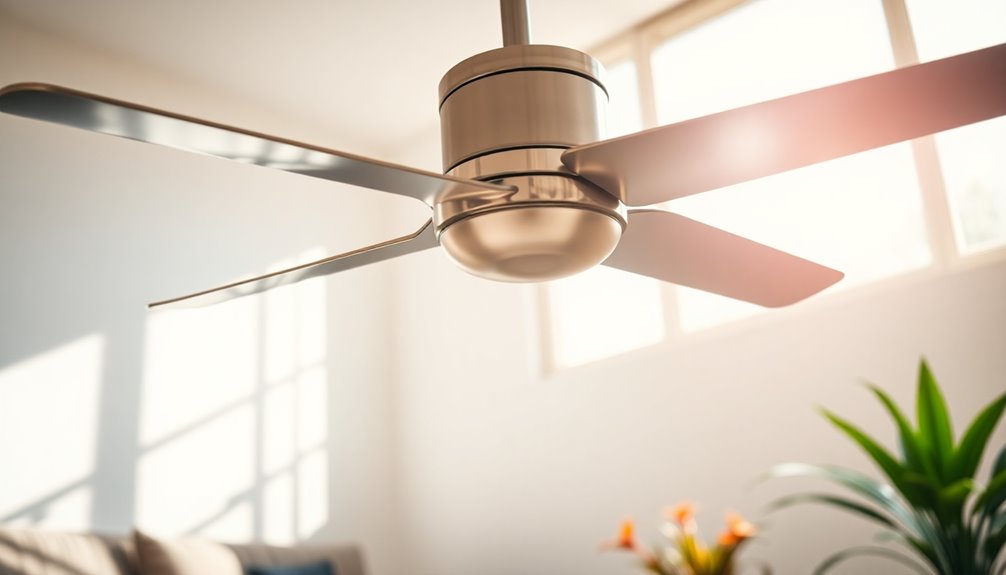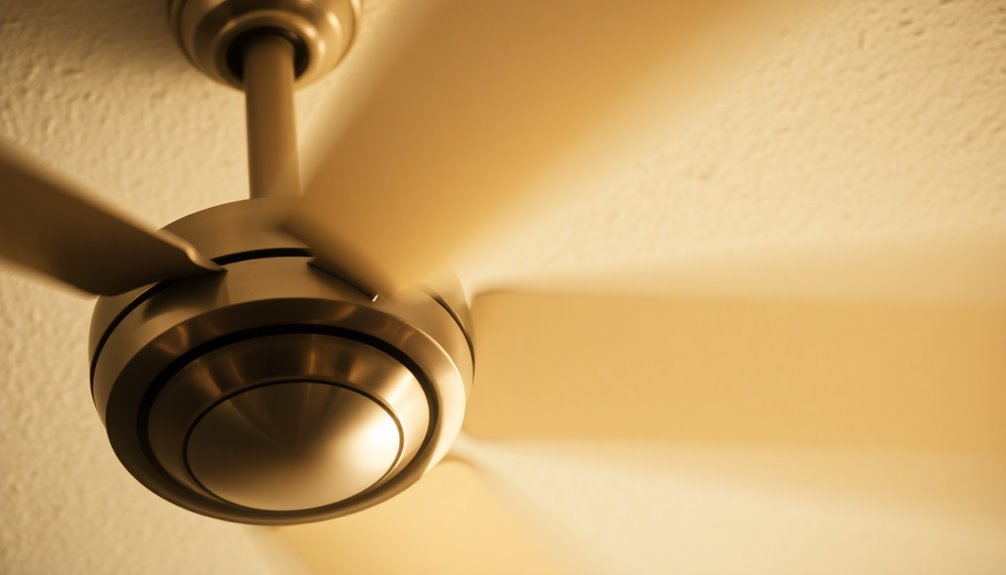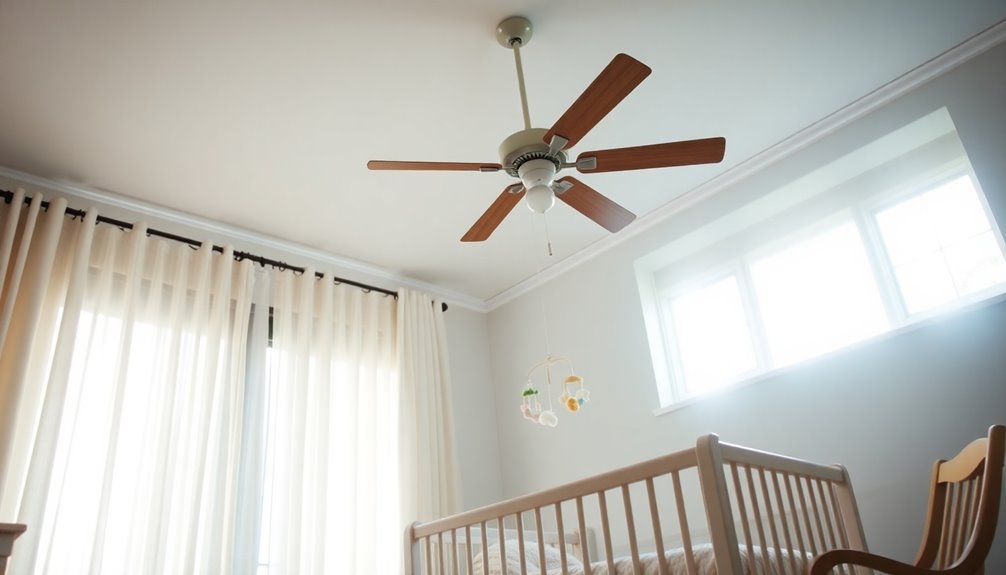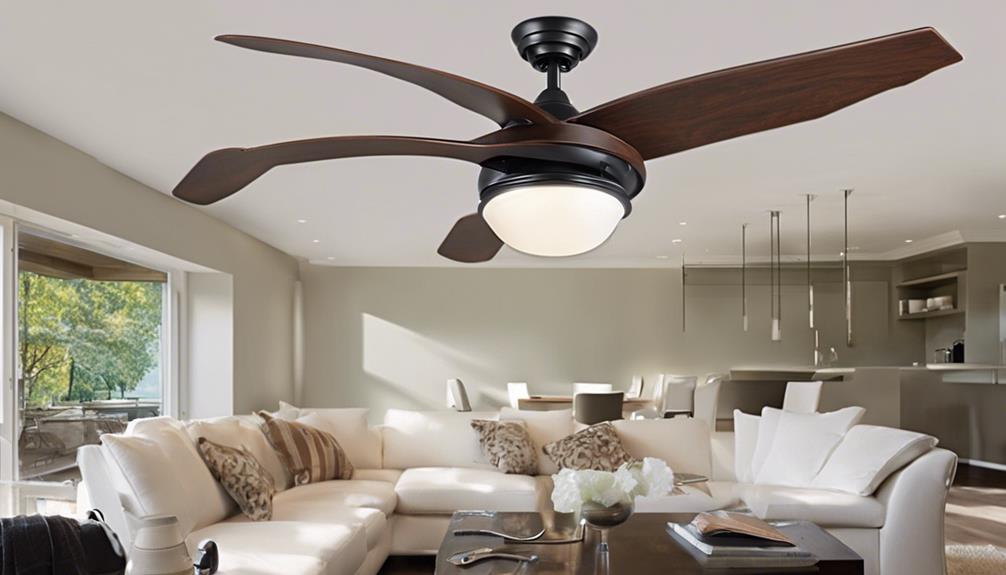Ceiling fans aren't supposed to wobble excessively. If you notice an unusual movement, it usually indicates a problem that needs attention. Common causes include loose screws, misaligned blades, and even dust accumulation. Additionally, warped blades or environmental factors can contribute to instability. A fan should run smoothly, and excessive wobbling can affect its lifespan and performance. Regular maintenance and inspections can help you spot issues early. If your fan continues to wobble after your efforts, you might need professional help. There's more to explore about fixing and maintaining your fan for peak performance.
Key Takeaways
- Ceiling fans are not supposed to wobble; excessive wobbling indicates potential issues that need addressing.
- Common causes of wobbling include loose screws, misaligned blades, and dust accumulation on the blades.
- A wobble greater than 1/8-inch is a serious concern and may pose safety risks.
- Quality fans are designed to minimize wobbling through superior materials and precision-balanced blades.
- Regular maintenance and inspection can prevent wobbling and ensure optimal performance of ceiling fans.
Causes of Ceiling Fan Wobbling

Ceiling fan wobbling can be frustrating, and it often stems from several common issues. One major cause is loose screws that secure the blades or blade holders. If these screws aren't tightened properly, they can compromise the fan's stability, leading to excessive wobbling during operation.
Misaligned blades also play a significant role in fan wobbling. If the blades are spaced unevenly or weighted differently, it disrupts the fan's balance, resulting in an unstable rotation.
Additionally, dust and dirt accumulation on one side of the blades can create an imbalance due to added weight. Regular cleaning can help maintain proper weight distribution.
Environmental factors like humidity and temperature changes can warp or bend the blades over time, further exacerbating wobbling issues. Bent blade irons or warped blades disrupt the fan's intended balance, causing it to wobble even more.
To tackle these problems, regularly check for loose screws, clean the blades, and verify they're properly aligned. By addressing these common causes, you can enjoy a smooth, wobble-free ceiling fan experience. Additionally, ensuring regular maintenance of ceiling fans can prevent potential issues before they escalate.
Signs of Imbalance in Fans

Wobbling fans often exhibit clear signs of imbalance that can be easily identified. If you notice a wobbly ceiling fan, it's important to address the issue promptly. One of the most noticeable signs of imbalance is excessive wobble, especially if it's more than 1/8-inch. This can pose safety risks and affect your fan's performance.
Additionally, if your fan produces unusual noises like rattling or buzzing, it likely indicates an imbalance, which can lead to motor wear.
Another factor to keep in mind is dust accumulation. If dirt builds up on one side of the blades, it can create uneven weight that contributes to fan wobble. You should also check the spacing between the blades and the ceiling; any irregularities can disrupt airflow and balance.
To maintain your fan's stability, make sure to check the screws regularly. Loose screws can greatly impact balance, so tightening them is vital.
Finally, don't forget that regular cleaning can prevent dust from accumulating and help keep your fan in good working order. By identifying these signs of imbalance, you can guarantee your ceiling fan operates smoothly and safely.
Tools for Fixing Wobbling Fans

To fix a wobbly ceiling fan, you'll need a few essential tools.
Grab a ladder or step stool to safely access the fan, along with a screwdriver for tightening any loose screws.
A ceiling fan balancing kit can also help you fine-tune the weight distribution and eliminate that annoying wobble.
Essential Tools Required
When you're ready to tackle the issue of a wobbly ceiling fan, having the right tools on hand is essential for an effective fix. First, grab a ladder or step stool to safely access your fan. This will help you inspect and tighten components without straining yourself.
Next, you'll need a screwdriver to tighten the screws on the mounting bracket, downrod, and blades. Loose screws are often the culprits behind wobbling, so don't skip this step.
A tape measure is also useful for checking the clearance between the fan blades and surrounding objects. Proper installation is key to minimizing wobble, and measuring guarantees your fan has enough space.
Additionally, don't forget a duster or cloth to clean dust accumulation from the blades. Dust can contribute to imbalance, making it essential to keep your fan clean.
Finally, while we won't explore the specifics of balancing kits just yet, having a ceiling fan balancing kit on hand can be a game-changer. These kits typically include clips and adhesive weights to help adjust weight distribution on the blades, further resolving wobbling issues.
With these tools ready, you're set to get that fan spinning smoothly again!
Balancing Kits Overview
A reliable balancing kit is an invaluable tool for fixing ceiling fan wobble. These kits typically include a plastic clip and adhesive weights, making it easier for you to identify and correct wobbling issues in your ceiling fan. Here's a quick overview of how to use a balancing kit effectively:
| Step | Description |
|---|---|
| Attach the Plastic Clip | Secure the plastic clip to the end of one blade while the fan is running. |
| Observe Wobble Changes | Watch for any changes in wobble to pinpoint the problematic blade. |
| Apply Adhesive Weights | Once identified, adjust the clip's position or apply adhesive weights to balance it. |
Regularly using balancing kits can help maintain the stability of your ceiling fan, ensuring it operates efficiently and prolongs its lifespan. After applying the weights, test the fan on high speed to confirm that you've successfully fixed a wobbly ceiling. This simple process can save you from potential issues and keep your fan running smoothly.
Step-by-Step Wobble Repair

To fix a wobbly ceiling fan, start by inspecting for loose screws and tightening them as needed.
Next, clean any dust from the blades, as buildup can contribute to imbalance.
Finally, if wobbling persists, use a balancing kit to help adjust the weight distribution on the blades.
Inspect for Loose Screws
Before diving into repairs, make certain to turn off the electricity supply to your ceiling fan. Safety first!
Now, it's time to inspect for loose screws, which is a vital step in ceiling fan repair. Grab a screwdriver and carefully check the screws on the blade holders. Confirm each fan blade is securely attached; loose blades can lead to a wobbly fan.
Next, don't forget to inspect the screws that hold the blade holder to the fan flywheel. If these screws are loose, they can contribute to instability and wobbling as well.
After tightening all visible screws, turn the fan back on to see if the wobble persists. If it does, further adjustments may be needed.
Regularly inspecting and tightening screws as part of your maintenance routine will help prevent future wobbling issues. Properly installed and maintained fans not only operate more efficiently but also enhance your comfort at home.
Clean Dust From Blades
After confirming that all screws are tight, the next step in addressing a wobbly ceiling fan is to clean the dust from the blades.
Start by turning off the ceiling fan and disconnecting the electricity supply to prevent any accidents during the cleaning process. Use a duster or a microfiber cloth to gently wipe the fan blades, focusing on the top surface where dust tends to accumulate. This buildup can add weight and contribute to a wobbling ceiling fan.
If you encounter stubborn dirt, dampen your cloth with a mild cleaning solution and carefully wipe the blades, but avoid using excessive moisture that could damage the fan's motor.
It's important to regularly clean dust from blades at least once a month to prevent dust buildup, which can lead to balance issues and reduced efficiency. Additionally, a clean ceiling fan can improve air quality and enhance the overall comfort of your living space.
Once you've cleaned the blades, run the fan at various speeds to check for any remaining wobble. This helps confirm that the fan blades are properly balanced and free of debris.
Use Balancing Kit
A ceiling fan's wobble can be frustrating, but using a balancing kit offers an effective solution. Here's how you can fix it step-by-step.
- Attach the Clip: While the fan is running, attach the provided plastic clip to the end of one fan blade. This helps you identify which blade is causing the wobble.
- Adjust the Clip: Move the clip along the blade until you find the position that minimizes the wobbling.
- Add Weights: Once you've found the ideal spot, replace the clip with adhesive weights and secure them firmly to the blade.
- Test the Fan: Run the fan at high speed to verify that the wobbling has been resolved.
- Periodic Check: Repeat this process regularly, especially if you've made adjustments or if environmental changes occur.
| Step | Action |
|---|---|
| 1. Clip Attachment | Attach clip to blade |
| 2. Position Adjust | Move clip to find balance |
| 3. Weight Addition | Replace clip with weights |
Using a balancing kit can restore stability to your fan, guaranteeing it operates smoothly.
Proper Blade Alignment Techniques

When it comes to ceiling fans, proper blade alignment is essential for smooth operation and minimal wobbling. Start by verifying that all blades are firmly secured to their respective blade holders. Loose connections can cause your fan to be wobbly during operation.
Next, measure the vertical distance from the ceiling to the tips of each blade using a yardstick. This helps confirm that the blades are at a uniform height, as uneven spacing can lead to imbalance.
Inspect and tighten the screws that attach the blade holder to the fan flywheel. Loose screws can contribute to misalignment, resulting in further wobbling. If you notice that a blade appears misaligned, gently bend the blade holder back into position. Be careful not to cause any further damage or warping.
After making these adjustments, run the fan at various speeds to check for wobbling. This step verifies that all blades maintain proper alignment and stability during operation.
Balancing Techniques and Kits

Balancing a ceiling fan is vital for eliminating wobble and guaranteeing a smooth operation. Using a balancing kit can make this task easier. A typical kit includes a plastic clip and adhesive weights, which help identify and correct wobbling issues by adjusting the weight distribution of the fan blades.
To start, attach the clip to the end of a blade and run the fan. Observe which blade causes the most wobble. This allows you to pinpoint where adjustments are needed. After identifying the problematic blade, you can move the clip along the blade to find the best balance.
Once you've determined the ideal position, secure the adhesive weights in place for a permanent solution.
It's important to regularly test the fan at high speed after making adjustments to verify any wobbling has been effectively resolved. If you notice changes in wobbling or perform maintenance on other components, it's a good idea to repeat the balancing process.
Maintenance Practices for Longevity

To guarantee your ceiling fan operates efficiently and lasts for years, regular maintenance is key.
Start with regular dusting of the fan blades to enhance efficiency and prevent dust accumulation, which can lead to a wobbling ceiling fan. Dust buildup not only affects performance but can also cause wear over time.
Next, inspect the fan for loose screws and connections. These can create instability and contribute to wobbling. Tightening any loose screws is a simple yet effective maintenance practice that guarantees your fan remains secure.
Periodic lubrication of the motor and moving parts is another essential task. This helps prevent mechanical issues and extends your fan's lifespan, keeping it running smoothly.
If your fan is over 10 years old, consider scheduling professional maintenance. Experts can identify and address potential mechanical issues before they escalate into significant problems.
Finally, test the fan operation at different speeds to detect any performance declines. This proactive approach allows for timely adjustments or repairs, guaranteeing your ceiling fan continues to provide reliable comfort throughout its lifespan.
Importance of Quality Fans

The importance of choosing quality ceiling fans cannot be overstated. Investing in quality fans guarantees you'll enjoy reduced wobbling, thanks to superior materials and advanced engineering. Fans with precision-balanced blades are designed to maintain stability at any speed, which enhances your comfort while minimizing noise levels.
Here's a quick comparison of different fan qualities:
| Feature | Low-Quality Fans | Quality Fans | Premium Fans |
|---|---|---|---|
| Materials | Basic plastic | Superior materials | High-grade metals |
| Blade Balance | Often unbalanced | Precision-balanced blades | Advanced balancing tech |
| Airflow Efficiency | Limited | Improved airflow efficiency | Maximum airflow output |
| Noise Level | Noisy | Quiet | Whisper-quiet operation |
| Warranty | Minimal warranty | Standard warranty | Extended warranty |
When to Seek Professional Help

Even with quality ceiling fans, issues like wobbling can still arise. If your fan wobbles persistently despite your attempts to balance it, it may indicate deeper mechanical issues that need a professional's diagnosis.
You should take action if the wobble exceeds 1/8-inch, as this poses safety risks for you and your loved ones.
Additionally, if your fan is over 10 years old and shows signs of wobbling, it might be time for expert servicing due to potential age-related mechanical problems.
Keep an ear out for buzzing sounds or unusual noises accompanying the wobbling. These can signal motor malfunctions, which require professional help to prevent further damage.
If you suspect complex installation issues or realize the fan was improperly mounted, consult a professional. They can guarantee secure and correct installation, helping to prevent future wobbling.
When in doubt, reaching out for professional assistance is always a smart move to maintain the safety and functionality of your ceiling fan.
Don't hesitate to seek help when you encounter persistent problems; it could save you time, money, and keep your home safe.
Frequently Asked Questions
Is It Okay if a Ceiling Fan Wobbles a Little?
It's generally okay for your ceiling fan to wobble a little, especially at high speeds.
Minor wobbling can often be fixed with simple maintenance, like dusting or tightening screws.
However, if you notice excessive wobbling—more than 1/8-inch—it's important to address it.
Consistent wobbling might indicate misalignment or loose parts that could strain the motor and reduce the fan's efficiency.
If it persists, consider seeking professional help.
How to Know if a Ceiling Fan Will Fall?
You mightn't realize it, but a ceiling fan can be a ticking time bomb in your home.
To know if it'll fall, watch for excessive wobbling or buzzing sounds. Inspect the mounting hardware and verify everything's tightly secured.
Check for loose screws or misaligned blades, as these issues can signal danger. Don't ignore these signs—act quickly to prevent a potentially hazardous situation that could lead to injury or damage.
How Do You Get the Wobble Out of a Ceiling Fan?
To get the wobble out of your ceiling fan, first, check that all blades are securely attached and screws are tight.
Use a ceiling fan balancing kit to pinpoint any weight distribution issues.
Regularly clean the blades to prevent dust buildup, which can cause imbalance.
Also, verify the fan's installation is correct and that the mounting bracket is secure.
Finally, measure the distance from the ceiling to the blade tips and adjust as needed.
Will an Unbalanced Ceiling Fan Fall?
An unbalanced ceiling fan can feel like a dance partner who's lost their rhythm—unpredictable and risky.
If your fan's wobbling excessively, it mightn't just be an eyesore; it could fall. While it's not common for well-installed fans to drop, any wobble over 1/8-inch should be addressed.
Regular maintenance keeps your fan in check. So, don't ignore those vibrations; tighten screws and balance the blades before you find yourself in a sticky situation!
Conclusion
In summary, while some wobbling is normal, excessive movement can signal an imbalance that needs fixing. For instance, imagine your ceiling fan swaying wildly during a summer evening, disrupting your relaxation. By following proper alignment and balancing techniques, you can restore peace to your space. Regular maintenance guarantees your fan runs smoothly for years. If the problem persists, don't hesitate to call a professional to keep your home comfortable and safe.









